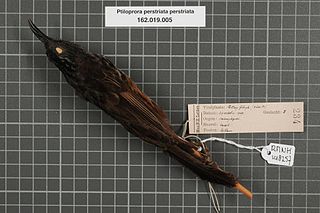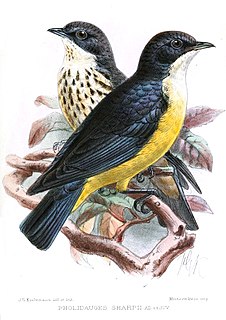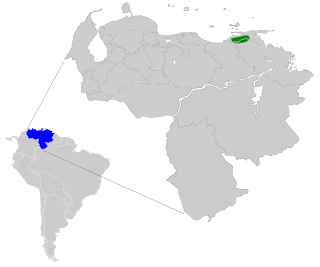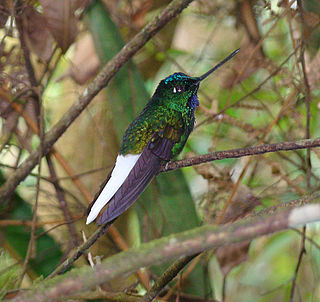 W
WThe Bismarck kingfisher is a species of bird in the family Alcedinidae that is endemic to Papua New Guinea.
 W
WThe black-banded fruit dove is a large pigeon with white head, neck and upper breast; black back and upperwing grading to grey on rump; black tail with broad grey terminal band; underparts grey, demarcated from white head and neck by broad black band.
 W
WThe carunculated fruit dove is a species of bird in the family Columbidae. It is endemic to Obira.
 W
WThe chestnut-quilled rock pigeon is a dark sooty brown pigeon with a distinctive bright chestnut patch on its wing visible in flight. It has distinctive pale lines across its face curving above and below its eye. A species of bird in the family Columbidae, it is very similar in behaviour and habitat to the white-quilled rock pigeon but it is only found on rocky escarpments in western Arnhem Land in the Northern Territory of Australia.
 W
WThe Colombian crake is a species of bird in the family Rallidae. It is found in Colombia, Ecuador, and Panama. Its natural habitats are subtropical or tropical seasonally wet or flooded lowland grassland and swamps.
 W
WThe flightless cormorant, also known as the Galapagos cormorant, is a cormorant endemic to the Galapagos Islands, and an example of the highly unusual fauna there. It is unique in that it is the only known cormorant that has lost the ability to fly. Once it was placed in its own genus, Nannopterum, although current taxonomy places it in the genus with most of the other cormorants, Phalacrocorax.
 W
WThe Flores hawk-eagle is a 75–79 centimetres (30–31 in) long raptor in the family Accipitridae. Adults have dark brown upperparts, a brown tail with six bars, a white patch in the wings that is visible in flight, white underparts, and a white head with fine brownish streaks on the crown. It has traditionally been treated as a subspecies of the changeable hawk-eagle; at least in part because of confusion over the true adult plumage of the Flores hawk-eagle, which resembles the juvenile of the changeable hawk-eagle. Unlike that species, adult and juvenile Flores hawk-eagles are quite similar.
 W
WThe Foveaux shag, together with the Otago shag formerly known as the Stewart Island shag and in its dark phase as the bronze shag, is a species of shag endemic to Stewart Island/Rakiura and Foveaux Strait, from which it takes its name.
 W
WThe giant kingbird is a species of bird in the tyrant flycatcher family Tyrannidae. It is endemic to Cuba, although there are historical records of it on other islands. The species is probably mostly closely related to the loggerhead kingbird, which also occurs in Cuba as well as several other nearby Caribbean islands.
 W
WThe grey-streaked honeyeater, also known as the black-backed honeyeater, is a species of bird in the family Meliphagidae. It is found in the New Guinea Highlands. Its natural habitat is subtropical or tropical moist montane forests.
 W
WThe Sula jungle flycatcher is a species of passerine bird in the Old World flycatcher family Muscicapidae. It is endemic to Sula Island in Indonesia where its natural habitat is subtropical or tropical moist lowland forests. It is threatened by habitat loss.
 W
WThe hooded parrot is a species of parrot native to the Northern Territory in Australia. It is found in savannah and open woodland and is one of two extant species in its genus that breed in termite mounds. It has declined from much of its original range.
 W
WThe long-tailed sylph is a species of hummingbird in the family Trochilidae. It is found in Bolivia, Colombia, Ecuador, Peru, and Venezuela. Its natural habitat is subtropical or tropical moist montane forest. It has an average lifespan of 3 to 4 years in the wild.
 W
WThe Lord Howe golden whistler, also known as the Lord Howe whistler or Lord Howe Island golden whistler, and locally as the “robin” or “yellow robin”, is a small bird in the whistler family, Pachycephalidae. It is a subspecies of the Australian golden whistler that is endemic to Lord Howe Island in the Tasman Sea, part of New South Wales, Australia.
 W
WThe Masai ostrich, also known as the East African ostrich is a red-necked subspecies variety of the common ostrich and is endemic to East Africa. It is one of the largest birds in the world, second only to its sister subspecies Struthio camelus camelus. Today it is hunted and farmed for eggs, meat, and feathers.
 W
WThe mountain mouse-warbler is a species of bird in the family Acanthizidae. It is found in Indonesia and Papua New Guinea, where its natural habitat is subtropical or tropical moist montane forests.
 W
WThe Raso lark is a small passerine bird with a highly restricted range, being found only on Raso islet in the Cape Verde Islands. This critically endangered member of the family Alaudidae lives in very arid terrain, and is considered one of the least known birds in the Western Palaearctic region, due to its remoteness and the lack of much ornithological study on the archipelago as a whole.
 W
WThe Santa Marta foliage-gleaner is a species of bird in the family Furnariidae. It is endemic to Sierra Nevada de Santa Marta in Colombia. It was formerly considered a subspecies of the ruddy foliage-gleaner. Evidence suggests that it possibly should be moved to the genus Hylocryptus.
 W
WSharpe's starling is a species of starling in the family Sturnidae. It is found in Burundi, the Democratic Republic of the Congo, Ethiopia, Kenya, Rwanda, South Sudan, Tanzania, and Uganda.
 W
WThe Sierra Nevada brushfinch is a species of bird in the family Passerellidae.
 W
WThe slate-throated gnatcatcher is a species of bird in the family Polioptilidae. It is found in Colombia, Ecuador, and Panama. Its natural habitat is subtropical or tropical moist lowland forests.
 W
WThe stub-tailed antbird is a species of bird in the family Thamnophilidae. It is found in Colombia and Ecuador. Its natural habitat is subtropical or tropical moist lowland forests.
 W
WThe Sula pitta is a species of the pitta. It was considered a subspecies of the red-bellied pitta. It is endemic to Indonesia where it occurs in the Sula and Banggai Islands. Its natural habitat is subtropical or tropical moist lowland forests. It is threatened by habitat loss.
 W
WThe Sula scops owl, is a small owl in the scops-owl genus Otus found on the Sula Islands of Indonesia. Taxonomically, some groups consider it to be a distinct species, others a subspecies of the Sulawesi scops owl, and yet others a subspecies of the Moluccan scops owl.
 W
WThe Sumba buttonquail is a species of bird in the family Turnicidae. The scientific name commemorates British colonial administrator and zoological collector Alfred Hart Everett.
 W
WThe Venezuelan sylph is a small bird in the hummingbird family, Trochilidae. It is restricted to the eastern Venezuelan Coastal Range and is classed as an endangered species by BirdLife International. It is sometimes considered to be a subspecies of the long-tailed sylph.
 W
WThe Wetar figbird is a species of bird in the family Oriolidae. It is endemic to forest, woodland and scrub on the Indonesian island of Wetar. The Wetar figbird remains poorly known, and although threatened by habitat loss, recent population estimates are greater than originally estimated, resulting in it being now listed as Least Concern by BirdLife International and the IUCN. The Wetar figbird resembles the better known Australasian figbird, but is much smaller and the male has entirely white underparts. Formerly, it has been considered a subspecies of the green figbird, but they are now classified as two separate species.
 W
WThe white-tailed starfrontlet is a species of hummingbird in the family Trochilidae. It is found in the Sierra Nevada de Santa Marta.
 W
WThe yellow-cheeked becard is a passerine bird in the family Tityridae. It is treated variously as a distinct species or as a subspecies of the green-backed becard, Pachyramphus viridis. It has traditionally been placed in Cotingidae or Tyrannidae, but evidence strongly suggest it is better placed in Tityridae, where now placed by the South American Classification Committee. It is mainly found in Ecuador and Peru.